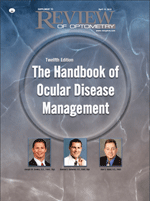Twelfth Annual Handbook of Ocular Disease Management
Read PDF Edition
To Our Colleagues:
The publication of the Twelfth edition of The Handbook of Ocular Disease Management coincides with many changes within the profession of optometry. Optometry has evolved from what was once a purely visual correction and refractive profession to an integrated member of the health care team.
There has been increased specialization within optometry to the point that optometrists now utilize intra-professional referrals rather than strictly using inter-professional referrals. We need to embrace the concept that eye care, patient care, and optometry have become so advanced that it is difficult for any single practitioner to be everything to every patient.
Optometric societies have developed to cater to and foster interest in specialized areas of optometry. Sub-specialization has become a real part of optometry. Referral to optometric colleagues for glaucoma and ocular disease management,vision therapy, low vision, and specialty contact lens fittings is now common place. Common to all of these changes is the need for optometrists to remain current and enhance their knowledge and education. Optometrists must commit to lifelong learning. Reading high quality peer-reviewed publications is necessary. Attending continuing education conferences that are free of commercial bias allows optometrists to keep current and interact, both socially and professionally, with colleagues.
We have always felt that the best way to begin this commitment to lifelong learning is through the completion of an accredited residency. Residency training not only provides increased clinical experience, it opens doors and initiates the lifelong learning process. To all optometry students (and practitioners) reading this manuscript, we strongly encourage you to pursue residency training.
Joe
Andy
Al
Additional Publications
-
The Value of Real Tears
Francis Mah, MD, and Jessica Steen, OD, FAAO, discuss the importance of a stable tear film, how real tears help maintain the health of the ocular surface and the effect that various dry eye interventions can have on tear film homeostasis.
Sponsored by Viatris A Wider View Of The Retina Advances Care
It’s Time to Talk to Your Patients about Digital Eye Strain
New Developments in Glaucoma
Ophthalmic Product Guide - February 2024
Preservatives in Eye Care: Intrepid Eye Society Consensus Discussion



